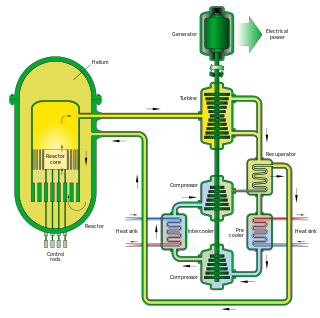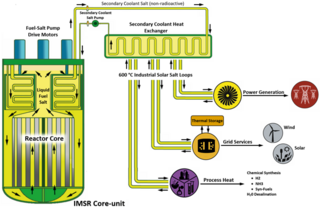
The CANDU is a Canadian pressurized heavy-water reactor design used to generate electric power. The acronym refers to its deuterium oxide moderator and its use of uranium fuel. CANDU reactors were first developed in the late 1950s and 1960s by a partnership between Atomic Energy of Canada Limited (AECL), the Hydro-Electric Power Commission of Ontario, Canadian General Electric, and other companies.

A nuclear reactor is a device used to initiate and control a fission nuclear chain reaction or nuclear fusion reactions. Nuclear reactors are used at nuclear power plants for electricity generation and in nuclear marine propulsion. Heat from nuclear fission is passed to a working fluid, which in turn runs through steam turbines. These either drive a ship's propellers or turn electrical generators' shafts. Nuclear generated steam in principle can be used for industrial process heat or for district heating. Some reactors are used to produce isotopes for medical and industrial use, or for production of weapons-grade plutonium. As of 2022, the International Atomic Energy Agency reports there are 422 nuclear power reactors and 223 nuclear research reactors in operation around the world.

A boiling water reactor (BWR) is a type of light water nuclear reactor used for the generation of electrical power. It is the second most common type of electricity-generating nuclear reactor after the pressurized water reactor (PWR), which is also a type of light water nuclear reactor.

A nuclear meltdown is a severe nuclear reactor accident that results in core damage from overheating. The term nuclear meltdown is not officially defined by the International Atomic Energy Agency or by the United States Nuclear Regulatory Commission. It has been defined to mean the accidental melting of the core of a nuclear reactor, however, and is in common usage a reference to the core's either complete or partial collapse.

A breeder reactor is a nuclear reactor that generates more fissile material than it consumes. These reactors can be fueled with more-commonly available isotopes of uranium and thorium, such as uranium-238 and thorium-232, as opposed to the rare uranium-235 which is used in conventional reactors. These materials are called fertile materials since they can be bred into fuel by these breeder reactors.

Magnox is a type of nuclear power / production reactor that was designed to run on natural uranium with graphite as the moderator and carbon dioxide gas as the heat exchange coolant. It belongs to the wider class of gas-cooled reactors. The name comes from the magnesium-aluminium alloy, used to clad the fuel rods inside the reactor. Like most other "Generation I nuclear reactors", the Magnox was designed with the dual purpose of producing electrical power and plutonium-239 for the nascent nuclear weapons programme in Britain. The name refers specifically to the United Kingdom design but is sometimes used generically to refer to any similar reactor.

The light-water reactor (LWR) is a type of thermal-neutron reactor that uses normal water, as opposed to heavy water, as both its coolant and neutron moderator; furthermore a solid form of fissile elements is used as fuel. Thermal-neutron reactors are the most common type of nuclear reactor, and light-water reactors are the most common type of thermal-neutron reactor.
Passive nuclear safety is a design approach for safety features, implemented in a nuclear reactor, that does not require any active intervention on the part of the operator or electrical/electronic feedback in order to bring the reactor to a safe shutdown state, in the event of a particular type of emergency. Such design features tend to rely on the engineering of components such that their predicted behaviour would slow down, rather than accelerate the deterioration of the reactor state; they typically take advantage of natural forces or phenomena such as gravity, buoyancy, pressure differences, conduction or natural heat convection to accomplish safety functions without requiring an active power source. Many older common reactor designs use passive safety systems to a limited extent, rather, relying on active safety systems such as diesel powered motors. Some newer reactor designs feature more passive systems; the motivation being that they are highly reliable and reduce the cost associated with the installation and maintenance of systems that would otherwise require multiple trains of equipment and redundant safety class power supplies in order to achieve the same level of reliability. However, weak driving forces that power many passive safety features can pose significant challenges to effectiveness of a passive system, particularly in the short term following an accident.

The gas-cooled fast reactor (GFR) system is a nuclear reactor design which is currently in development. Classed as a Generation IV reactor, it features a fast-neutron spectrum and closed fuel cycle for efficient conversion of fertile uranium and management of actinides. The reference reactor design is a helium-cooled system operating with an outlet temperature of 850 °C using a direct Brayton closed-cycle gas turbine for high thermal efficiency. Several fuel forms are being considered for their potential to operate at very high temperatures and to ensure an excellent retention of fission products: composite ceramic fuel, advanced fuel particles, or ceramic clad elements of actinide compounds. Core configurations are being considered based on pin- or plate-based fuel assemblies or prismatic blocks, which allows for better coolant circulation than traditional fuel assemblies.

The High Flux Isotope Reactor (HFIR) is a nuclear research reactor at Oak Ridge National Laboratory (ORNL) in Oak Ridge, Tennessee, United States. Operating at 85 MW, HFIR is one of the highest flux reactor-based sources of neutrons for condensed matter physics research in the United States, and it has one of the highest steady-state neutron fluxes of any research reactor in the world. The thermal and cold neutrons produced by HFIR are used to study physics, chemistry, materials science, engineering, and biology. The intense neutron flux, constant power density, and constant-length fuel cycles are used by more than 500 researchers each year for neutron scattering research into the fundamental properties of condensed matter. HFIR has about 600 users each year for both scattering and in-core research.

North Carolina State University in 1950 founded the first university-based reactor program and Nuclear Engineering curriculum in the United States. The program continues in the early 21st century. That year, NC State College administrators approved construction of a reactor and the establishment of a collegiate nuclear engineering program. The first research reactor was completed in 1953; it was scaled up in 1957 and 1960. It was deactivated in 1973 to make way for the PULSTAR reactor. The old reactor has been decommissioned.

The BN-600 reactor is a sodium-cooled fast breeder reactor, built at the Beloyarsk Nuclear Power Station, in Zarechny, Sverdlovsk Oblast, Russia. It has a 600 MWe gross capacity and a 560 MWe net capacity, dispatched o the Middle Urals power grid. It has been in operation since 1980 and represents an evolution on the preceding BN-350 reactor. In 2014, its larger sister reactor, the BN-800 reactor began operation.

The University of Florida Training Reactor (UFTR), commissioned in 1959, is a 100 kW modified Argonaut-type reactor at the University of Florida in Gainesville, Florida. It is a light water and graphite moderated, graphite reflected, light water cooled reactor designed and used primarily for training and nuclear research related activities. The reactor is licensed by the Nuclear Regulatory Commission and is the only research reactor in Florida.
The Ford Nuclear Reactor was a facility at the University of Michigan in Ann Arbor dedicated to investigating the peaceful uses of nuclear power. It was a part of the Michigan Memorial Phoenix Project, a living memorial created to honor the casualties of World War II. The reactor operated from September 1957 until July 3, 2003. During its operation, the FNR was used to study medicine, cellular biology, chemistry, physics, mineralogy, archeology, anthropology, and nuclear science.

Jōyō (常陽) is a test sodium-cooled fast reactor located in Ōarai, Ibaraki, Japan, operated by the Japan Atomic Energy Agency. The name comes from the previous country name of the area around Ibaraki.

The MIT Nuclear Research Reactor (MITR) serves the research purposes of the Massachusetts Institute of Technology. It is a tank-type 6 megawatt reactor that is moderated and cooled by light water and uses heavy water as a reflector. It is the second largest university-based research reactor in the U.S. and has been in operation since 1958. It is the fourth-oldest operating reactor in the country.

Iran's nuclear program is made up of a number of nuclear facilities, including nuclear reactors and various nuclear fuel cycle facilities.

The Pakistan Atomic Research Reactor or (PARR) are two nuclear research reactors and two other experimental neutron sources located in the PINSTECH Laboratory, Nilore, Islamabad, Pakistan.

The Integral Molten Salt Reactor (IMSR) is a nuclear power plant design targeted at developing a commercial product for the small modular reactor (SMR) market. It employs molten salt reactor technology which is being developed by the Canadian company Terrestrial Energy. It is based closely on the denatured molten salt reactor (DMSR), a reactor design from Oak Ridge National Laboratory. It also incorporates elements found in the SmAHTR, a later design from the same laboratory. The IMSR belongs to the DMSR class of molten salt reactors (MSR) and hence is a "burner" reactor that employs a liquid fuel rather than a conventional solid fuel; this liquid contains the nuclear fuel and also serves as primary coolant.
The Indian Pressurized Water Reactor-900 (IPWR-900) is a class of pressurized water reactors being designed by Bhabha Atomic Research Centre (BARC) in partnership with Nuclear Power Corporation of India Limited to supplement the Indian three-stage nuclear power programme

















